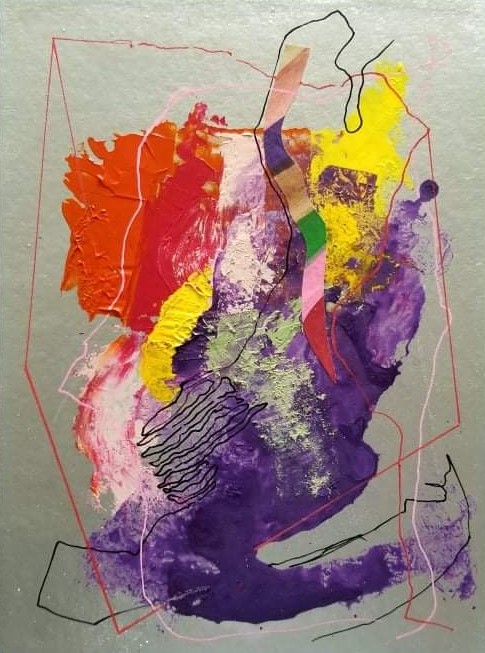Art: Rational Spaces No. 04 by DEGO (Detlef Gotzens)
Space Journal: Serendipity
En route to Andromeda
I launch luminous spheres
into the black desert of space
to measure the expansion
of the Universe
Back to the garden
The air sparkles
Hildegard Behrens singing
Brünnhilde’s dilemma
Resist the urge to touch
rainbow fish in the lily pond
Climb the aspen tree
Its eyes latch on to my toes
Light takes two million years
to reach Andromeda
The Universe is almost empty
A cat’s reflection gazes back at me
from the dome’s translucent dark vault
In the author’s words:
Yun Wang is the author of poetry books “The Book of Mirrors” (White Pine Press Poetry Prize 2020), “The Book of Totality” (Salmon Poetry Press, 2015), and “The Book of Jade” (Winner of the 15th Nicholas Roerich Poetry Prize, Story Line Press, 2002), and the book of poetry translations “Dreaming of Fallen Blossoms: Tune Poems of Su Dong-Po” (White Pine Press, 2019). Wang’s poems have been published in numerous literary journals, including The Kenyon Review, Prairie Schooner, Cimarron Review, Salamander Magazine, Valparaiso Poetry Review, Green Mountains Review, and International Quarterly. Her translations of classical Chinese poetry have been published in The Kenyon Review Online, Salamander Magazine, Poetry Canada Review, Willow Springs, Kyoto Journal, Bat City Review, Xavier Review, Connotation Press, and elsewhere. Wang was born in China, and came to the U.S. for graduate school in 1985. She is an astrophysicist at California Institute of Technology, currently focusing on developing space missions to explore the Universe.
https://www.amazon.com/Book-Mirrors-Yun-Wang/dp/1945680474
About the artist:
DEGO, Detlef Gotzens’ multi-medium artwork is stark and peerless, the product of a long and varied career in the arts.
In his adolescence, he found himself excelling in one of art’s most traditional and revered niches: stained glass design. Born in Cologne, Germany, he became an apprentice to Jacob Melchoir at the age of fifteen. Soon after completing his apprenticeship and receiving his journeyman certificate, he went on to study glass technology and design at Rheinbach’s prestigious Glass College. His success as an artist continued after he immigrated to Canada, where he opened his own atelier, and was commissioned to work on restoration projects for some of eastern Canada’s most recognizable churches, including St. Joseph’s Oratorio and Notre Dame Cathedral, as well as the Peace Tower on Parliament Hill. DEGO told Ottawa Life Magazine that during his work on the Peace tower they were running into technical difficulties and there were several barriers making progress difficult. He recommended that some of the key people on the project visit the Cologne Cathedral and speak with some of the world renowned architectural and design excerpts who had worked to restore that famous landmark and many others. The trip provided Gotzen and others on the Peace Tower restoration team with new ideas and innovations to make the project a success.
Throughout his years as a stained-glass artist, DEGO rarely painted or drew outside of his plans and designs for stained glass windows. He slowly started to create original paintings and sculptures under the name “Dego,” though he focused on his high-profile stained-glass commissions. Gotzens decided to commit himself full-time to his original artwork in 2009. Since then, his art has been celebrated, even being displayed in the famous Saatchi Galley in London, England.
The art itself is visceral, visually arresting. It is comparable to Pablo Picasso’s early Dadaist work, or Salvador Dali’s surrealist dreamscapes, only abstracted even further. In some cases, “DEGO’s” sculptures incorporate his training in glass: “I Can Fly” features a spindly, wiry bottom, supporting a stained-glass wing, encapsulating a sense of boundless freedom in its form. “Enchanting Shard” is defined by a clash of rigid and free-flowing shapes, with dark blues attempting to bring structure to the earthy hues that float around inside the glass.
His paintings also contain this same controlled chaos They feature familiar figures – such as roses, thrown into visual turmoil, seeming to represent definite beauty in an otherwise subjective world. Two of his painted works on display at Ottawa’s Alpha Art Gallery are defined by swirling, dripping streaks of earthy shades, seemingly arbitrary lines of paint that, together, create an image that is cathartic to its core.
DEGO’ finished products act as reflections of his artistic approach, as he is driven by impulse. He has a symbiotic relationship with his art: he creates what his work demands, and in return, it reflects his personhood. Depending on the medium that he is working with, it reflects a different aspect of his self. Whereas working with glass is a highly technical process, painting and sculpting are far more freeing.
“I believe that in my paintings as well as sculptures there are elements of free expression and, then again, of controlled form and order, which is certainly a manifestation of my personality showing through or reflecting in my work,” he explains.
DEGO paints to discover truth, whether it exists in him or in society. Painting is, for him, a visual language, for him to communicate with the world around him, an invitation for response. Gotzens touches on something very raw in his work: his art may be challenging and complex, but so are the emotions and truths that he is communicating through his abstract portrayals of his self and his world.



Always a delight to see one of Yun’s poems out and about, where many can see her work and appreciate it.